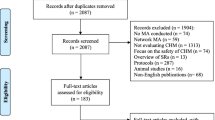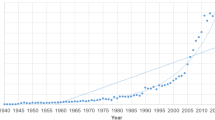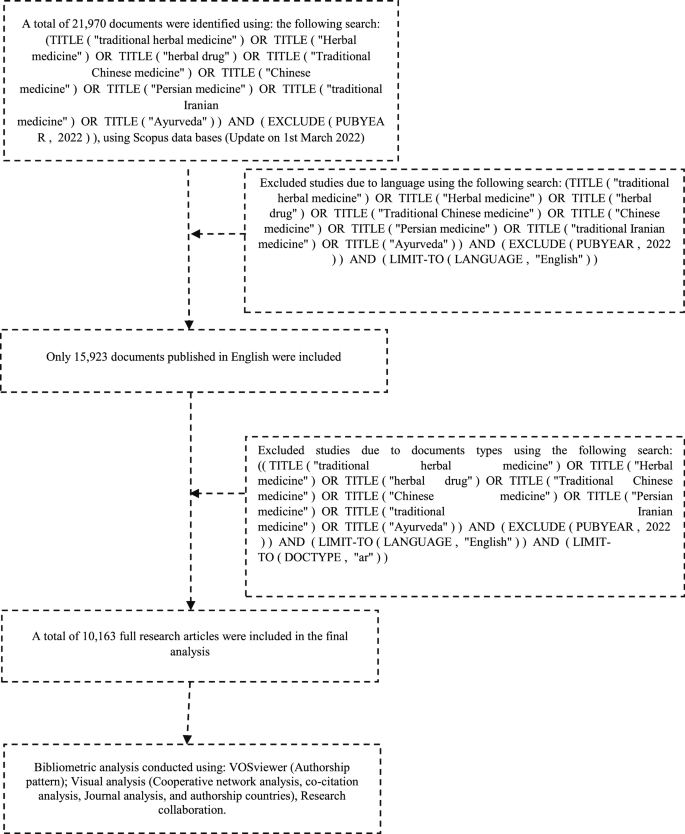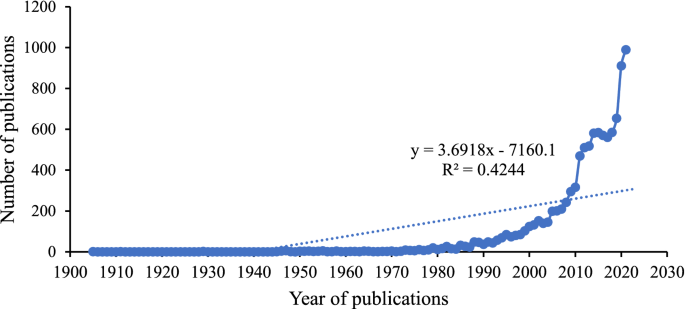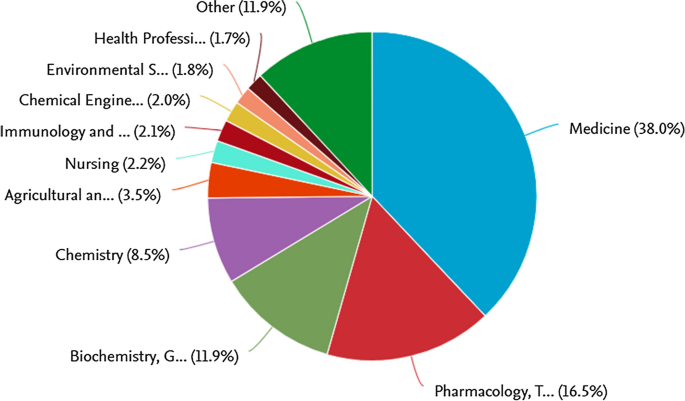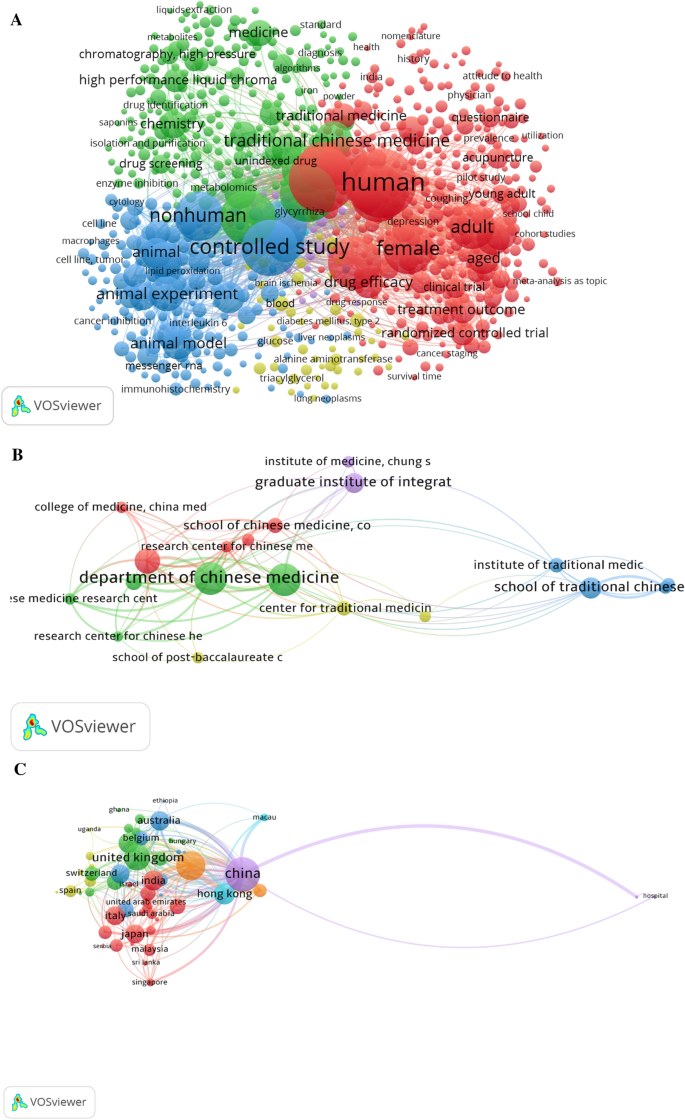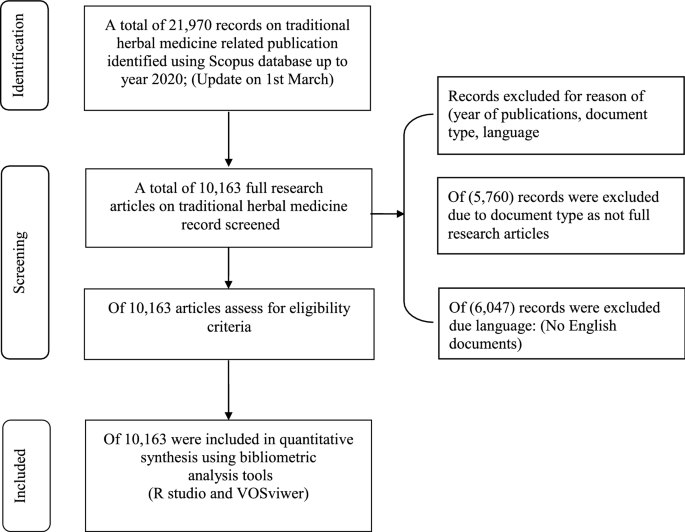Abstract
Traditional herbal medicine has been playing an essential role in primary health care globally. The aim of this work is to present an overview of traditional herbal medicine research productivity over the past years. The data was accessed from the Scopus database (www.scopus.com), while VOSviewer.Var1.6.6, Bibliometrix, and R studio were used for further analysis of the obtained data. The results showed that researches on traditional herbal medicine increased annually after 1990, followed by a corresponding increase in global citations during the period, with a total of 22,071 authors contributing to all the publications. Yiling Wang of Shanghai Institute of Drug Control, Shanghai, China was the most productive author (TNP = 303), while Journal of “Evidence-based Complementary and Alternative Medicine”, and “Journal of Ethnopharmacology” were the top ranked journals, respectively. Also, China, Japan, and India were found to be the top Corresponding Author's Countries for researches on traditional herbal medicine, as Beijing University of Chinese Medicine, China Academy of Chinese Medical Sciences and China Medical University were top affiliations. Moreover, National Natural Science Foundation of China, National Key Research and Development Program of China, Ministry of Science and Technology of the People's Republic of China, and Ministry of Science and Technology, Taiwan were top funding agencies, with more than 100 documents. The bibliometric research study has revealed an annual increasing trend in traditional herbal medicine, while also revealing that the topmost ranked authors and funding agencies were from Asia especially China.
Similar content being viewed by others
Avoid common mistakes on your manuscript.
Introduction
Traditional herbal medicine (or alternative herbal medicine) has played an essential role as a source of primary health care for many, globally (Maroyi and Cheikhyoussef 2015), as it has maintained the health of majorly Africans and Asians for thousands of years with a unique medical system built based on empirical- and accumulated knowledge. It has been reported that ~ 70–80% of Africa’s emerging urban and rural population rely on traditional herbal medicine for health intervention (Hostettmann et al. 2000; Lee et al. 2019), and even at the moment, billions of people around the world are taking traditional herbal medicine daily in form of food, drugs or supplements (Aydin et al. 2016). Traditional herbal medicine have been reported to have been used to cure or prevent many diseases and ailments including gastroesophageal reflux disease (Dai et al. 2020), prevents postoperative recurrence of small hepatocellular carcinoma (Zhai et al. 2018), adjuvant for chemo- and radiotherapy for cancer (Qi et al. 2010), adjunctive therapy for nasopharyngeal cancer (Kim et al. 2015), resectable gastric cancer (Lee et al. 2018), treatment of viral infections, stress and anxiety as well as improve mental health during Covid-19 pandemic (Shahrajabian et al. 2021; Yu et al. 2020), just to mention a few. Therefore, sustainable management towards traditional herbal medicine, the reactions, and challenges in the monitoring and safety of plant resources are essential sources of new drugs development which are used in treating several diseases ranging from general body pain to complicated diseases in humans (Kutalek and Prinz 2005; Maroyi and Cheikhyoussef 2015).
Bibliometric analysis has been used in many fields including Covid-19 and mental health (Akintunde et al. 2021), gum arabic (Musa et al. 2021a), neem (Onasanya et al. 2022) and in diseases such as sickle cell anemia (Musa et al. 2021b), anticancer research using herbal medicine (Basu et al. 2017), herbal medicine for pain (Wang and Meng 2021), medical treatment of cardiovascular diseases (Huang et al. 2016), and natural products against cancer (Du and Tang 2014). The findings from these studies have helped researchers to explore new directions for future research while also playing a fundamental role in decision making regarding policy, in addition to identifying new perspectives on potential collaborations in these fields (Basu et al. 2017; Du and Tang 2014; Huang et al. 2016; Musa et al. 2021a, 2021b; Wang and Meng 2021). However, there is yet any bibliometric analysis reportedly conducted to enhance the understanding of research hotspots, frontiers, and trends in the traditional herbal medicine indexed in the Scopus, as this will initaiate a focus on future researches and identify gaps, hence assist to explore current patterns and trends in literatures (Dol et al. 2021). Furthermore, using bibliometric analysis will enable researchers have a good grasp of the basic characteristics of the publications done over the years with empirical evidence on traditional medicine.
Therefore, in order to identify and further promote the growth and development of traditional herbal medicine, we used Bibliometric analysis to analyse all the published literatures therein. This technique can draw the primary bibliometric landscapes of the development of topics, highlighting the most active authors, influential countries or regions, topmost research interests in the fields and the hot topics covered over the past years, in addition to the international and national collaboration networks among authors, countries or regions. Hence, this paper aims to establish via analysis, the research productivity on the traditional herbal medicines indexed in the Scopus database, while assessing the research gaps by reviewing the published literatures.
Materials and methods
Sources of data
A bibliographic data acquisition was carried out using the Scopus database (https://www.scopus.com/) updated to March 2, 2022. Scopus is a world leading scientific database widely known for its extensive database of abstracts and citations which offers researchers the most comprehensive literature (covering all fields of natural sciences, medicine, social sciences and life sciences) retrieval.
Search strategy
We developed our search by examining related publications on traditional herbal medicine using the following query with the corresponding search approach based on:
TITLE ("traditional herbal medicine") OR TITLE ("Herbal medicine") OR TITLE ("herbal drug") OR TITLE ("Traditional Chinese medicine") OR TITLE ("Chinese medicine") OR TITLE ("Persian medicine") OR TITLE ("traditional Iranian medicine") OR TITLE ("Ayurveda") AND (EXCLUDE (PUBYEAR, 2022) OR EXCLUDE (PUBYEAR, english AND limit-to AND doctype)) AND (LIMIT TO (DOCTYPE, "ar")) AND (LIMIT-TO (LANGUAGE, "English")).
To ensure the high quality and academic nature of the literatures, only full research articles published in English were included. Initially, the search query returned 10,163 documents and the authors thereafter screened the titles of these articles for relevance. The total extracted docuemtns were harvested after retrieval and saved as Bib format, CSV format, and RIS format for further analysis using the bibliometric tool to run the frequency and generating, visualizing, and analyzing the maps. Two authors (THM and HHM) used bibliometric techniques to set a protocol to retrieve and collect reliable and relevant publications on traditional herbal medicine, as shown in Fig. 1. More also, the research category and organisations which enhanced the research productivity over the years were manually retrieved, while the quality of publication was assessed by calculating author’s or journal’s H-index (Fassin and Rousseau 2019; Garfield et al. 2006). The Journals’ impact factor (IF) for the year 2020 was also considered for visualising analysis results by using two bibliometric visualization tools (Garfield et al. 2006).
Data analysis analysis
Bibliometric data were presented using descriptive mapping analysis via VOSviewer, while Var1.6.6 was used for developing, constructing and viewing the bibliometric maps analysis by the unit of co-occurrence analysis, co-citation and bibliographic coupling to examine the length (L) or total length strength (TLS) occurrences or reports between authors, keywords in the titles, abstracts, organizations and countries within the distributed clusters (van Eck and Waltman 2010). Also, bibliometrix and a R package were used to perform the comprehensive bibliometric science mapping analysis (Dervis 2019).
Results
Basic characteristics of global publication analysis
In total, 10,163 articles met the criteria of articles published during year 1909 to 2021. It was observed that there was an annual increase in the number of publications after the year 1990 (Fig. 2). Of the 10,163 publications, an average of 15.09 citations per documents were found in 2552 Journals, which involved 22,071 authors with 2.34 Collaboration Index (CI) (Table 1).
Analysis of 10 top highly-cited documents
The recognition of a document on traditional herbal medicine can be reflected by the number of times it is cited, as presented in Table 2, on the descriptive analysis of the top 10 articles that have been published on the domain per citation during the years of investigation. An article titled “TCMSP: a database of systems pharmacology for drug discovery from herbal medicines” which was published in the Journal of Cheminformatics by Ru JL et al. (Ru et al. 2014) received the top-ranked cited article with 1346 citations and 149.5556 Total Citations Per Year. This was followed by the article “Some traditional herbal medicines, some mycotoxins, naphthalene and styrene, published with World Health Organization International Agency for Research On Cancer (WHO–IARC 2002) which received 774 citations and 36.8571 Total Citations Per Year (Table 2).
Journal analysis and quality of the publication
A total of 2552 journals were involved in the publication of traditional herbal medicine researches indexed in the Scopus database. The analysis revealed that the Journal of “Evidence-based Complementary and Alternative Medicine” was the topmost productive journal (h_index = 32, TNP = 401), followed by Journal of Ethnopharmacology (h_index = 57, TNP = 359) and then Chinese Journal of Integrative Medicine (h_index = 18, TNP = 253) as presented in Table 3.
Evaluation of scientific research by geographical area
In the evaluation of the scientific output based on geographical area, it was found that ninety-four (94) Corresponding Author's Countries contributed to the traditional herbal medicine-based published works, out of which only the top 10 most productive countries were listed in Table 4. People’s Republic of China was revealed to be the most productive (TNP = 4585), followed by the Japan (TNP = 730), India (TNP = 485), USA (TNP = 479) and Korea (TNP = 339), respectively. Meanwhile, the highly cited countries revealed that China is the topmost with reported 67,287 citations at an average citation of 14.675, followed by Japan with 14,372 citations at an average of 19.688 citations and then United States of America with 13,011 at an average of 27.163 citations, while Germany (3163 citations at an average of 27.991 citations) and Iran (1848 citations at an average of 9.625 citations) are coming from the rear back, on traditional herbal medicine-based researches published during the study period.
Authors productivity and co-authorship analysis
On the authors’ productivity, a total of 22,071 authors have been revealed to have contributed to traditional herbal medicine publications within the study period. The analysis of the top 10 authors shows that Yiling Wang from Shanghai Institute of Drug Control, Shanghai, China has the highest contribution with 303 published articles and an H_index of 39, followed by Zhang Y of Yunan University of Chinese Medicine College with 228 published documents and an H_index of 27, among other reported authors, as given in Table 5.
Top subject areas and funding sponsors for research on traditional herbal medicine
In order to analyse the key subject areas in relation to traditional herbal medicine, most of published articles were indexed in field of Medicine (6005; 38.0%), Pharmacology, Toxicology and Pharmaceutics (2607; 16.5%), Biochemistry, Genetics and Molecular Biology (1885; 11.9%), Chemistry (1341; 8.5%), Agricultural and Biological Sciences (552; 3.5%), Nursing (343; 2.2%), Immunology and Microbiology (337; 2.1%), Chemical Engineering (320; 2.0%), Environmental Science (277; 1.8%), Health Professions (273; 1.7%), amongst other subject areas (Fig. 3). Moreover, majority of research fundings emanated form National Natural Science Foundation of China, National Key Research and Development Program of China, and Ministry of Science and Technology of the People's Republic of China. Furthermore, Beijing University of Chinese Medicine, China Academy of Chinese Medical Sciences, China Medical University, and Shanghai University of Traditional Chinese Medicine were amongst the top listed affiliations (Table 6).
Co-occurrence analysis
The network visualization of co-occurrence indicates the frequency number of a keyword that appeared to determine the hot topics, while the color of each point on the map represents the density of the term over the past years, and the color represents the cluster. Also, the lines between the items represent the links. All Keywords (the minimum number of occurrences of keyword with over 300) were selected, as only 81 Keywords met the threshold and were included in the network analyses, which show different occurrences of the topic as organized into three (3) clusters with links and total link strength given between the keywords (L = 3118, TLS = 521,963), as shown in (Fig. 4A).
Co-author networks analysis among authors, organizations, and countries or regions
Based on a threshold of 10, the minimum number of documents for an author was selected, yielding a total of 47 organizations (Fig. 4B), which were thereafter organized into 5 distinct groups/clusters with links and total links strength (L = 77, TLS = 346), while countries were organized into 7 clusters with links and total links strength (L = 420, TLS = 2285), as shown in Fig. 4C.
Discussion
Bibliometrics has played a significant role in influencing policymaking as well as presenting a better understanding of scientific fields (Akintunde et al. 2021; Onasanya et al. 2022). The data for this study were retrieved from Scopus because the database provides different h_index ratings for authors who will need them to track citations and determine the impact of their publications (Musa et al. 2021c). The total number of traditional herbal medicine related-publications has been increasing annually since the year 1990, as traditional herbal medicine has gained attractive attention due to easy accessibility, affordability, safety, promising efficacy, and being environmentally bening (Musa et al. 2021d; Shahrajabian et al. 2019). Their essential roles in public health have led many people of different nationalities to rely on traditional herbal medicince (Soleymani and Shahrajabian 2018), as many herbs and plants included in several traditional systems have promising bioactive compounds for modern drug therapy (Shahrajabian et al. 2020) (Fig. 5).
The recognition of a document on traditional herbal medicine can be reflected by the number of times it is cited as presented in Scopus and other databases. “TCMSP: a database of systems pharmacology for drug discovery from herbal medicines” (Ru et al. 2014) and “Some Traditional Herbal Medicines, Some Mycotoxins, Naphthalene and Styrene” (WHO–IARC 2002) were reported to have being the most influential documents, with the highest number of total citations, as the research of J. Ru and coworkers (Ru et al. 2014) focussed on drug discovery from herbal medicines.
The analysis of journals based on h_index, total citations, number of documents, and Journal impact factors for the year 2021, revealed that Evidence-Based Complementary and Alternative Medicine, Journal of Ethnopharmacology and Chinese Journal of Integrative Medicine were the topmost ranked journals, based on their total number of publications, total citations and h_index, as these journals are more concentrated in traditional herbal medicines.
Also, the total number of traditional herbal medicine-focused publications generated 94 countries, with China, Japan, India and the USA being the topmost ranked countries in that order. This is in addition to the top 10 most productive authors coming only from China. This is of no coincidence as China is a reservoir of various high-valued medicinal plants, which have been used in the cosmetics, nutraceutical and pharmaceutical industries (Sun and Shahrajabian 2020). Increasing the research productivity in China is an indicator of the previous published reports that highlighted that herbal medicine is an essential part of traditional medicine which is part of Chinese culture. Moreso, traditional herbal medicine has been in practise in China for thousands of years (Fabricant and Farnsworth 2001). Due to the importance of traditional chinese herbal medicine in Chinese culture, Beijing University of Chinese Medicine and the Chinese Academy of Chinese Medical Sciences were the highest ranked in Organizations-enhanced traditional herbal medicine researches, as the top ten affiliations based on traditional herbal medicines were mainly Chinese domiciled, while the other developing countries are still lagging in conventional herbal medicine research productivity, although most developing countries depend on conventional herbal medicine to treat many diseases (Sen and Chakraborty 2017). The lagging in traditional herbal medicine-based researches in most developing countries could be attributed to fewer funding agencies that support scientific researches with grants. The results further revealed that the top ranking authors were Yiling Wang, Zhang Y, Yan-Da Li and Jong-Jing Wang, while Beijing University of Chinese Medicine, Chinese Academy of Chinese Medical Science, China Medical University and Shanghai University of Traditional Chinese Medicine, all based in China, were top ranking organizations. Furthermore, the cooperation networks facilitated by the creation of a database for storing a large portion of the data and their transformation into valuable information, has effectively contributed to the progress of the traditional medicine information system (Noraziah et al. 2011). Noteworthy, China’s Comprehensive Herbal Medicine Information System for Cancer has served as an appropriate information resource for traditional medicine researchers (Fang et al. 2005), while Web-based Decision Support System for Prescription in Herbal Medicine could play a significant role in controlling the quality of the herbal drugs prescriptions. Also, developed for consulting with the patients in the e-health system, e-health Record System in Australia has successfully assisted traditional medicine practitioners in the treatment management (Bjering et al. 2011). Although, there are some limitations as we have only included documents published in English language, while only one database, Scopus was used even though other databases such as Web of Sciences (WoS), Embase, PubMed, and Google scholar have also contributed extensively in the coverage of traditional herbal medicine researches.
Conclusions
The current study is the first bibliometric analysis of traditional herbal medicine scientific researches and publications. The study has shown an increasing publishing trend in recent years, in addition to identifying the global patterns of research, which serves as a tool in supporting the decisions and policies in traditional medicine. However, there is a need to increase research activities and international collaborations, particularly in developing countries as the present world system has been pushing for green and natural products rather than the synthetic ones.
References
Akintunde TY, Musa TH, Musa HH, Musa IH, Chen S, Ibrahim E, Tassang AE, Helmy MSEDM (2021) Bibliometric analysis of global scientific literature on effects of COVID-19 pandemic on mental health. Asian J Psychiatr 63:102753. https://doi.org/10.1016/j.ajp.2021.102753
Aydin A, Aktay G, Yesilada E (2016) A guidance manual for the toxicity assessment of traditional herbal medicines. Nat Prod Commun 11:1763–1773. https://doi.org/10.1177/1934578x1601101131
Basu T, Mallik A, Mandal N (2017) Evolving importance of anticancer research using herbal medicine: a scientometric analysis. Scientometrics. https://doi.org/10.1007/s11192-016-2223-8
Bjering H, Ginige A, Maeder A, Bensoussan A (2011) Electronic medical record information system for patient consultations in chinese medicine. Stud Health Technol Inform 168:10–15. https://doi.org/10.3233/978-1-60750-791-8-10
Dai YK, Wu YB, Wen H, Li RL, Chen WJ, Tang C, Lu L, Hu L (2020) Different traditional herbal medicines for the treatment of gastroesophageal reflux disease in adults. Front Pharmacol. https://doi.org/10.3389/fphar.2020.00884
Dervis H (2019) Bibliometric analysis using bibliometrix an R package. J Scientometr Res. https://doi.org/10.5530/JSCIRES.8.3.32
Dol J, Campbell-Yeo M, Dennis C-L, Leahy-Warren P (2021) Bibliometric analysis of parental anxiety and postpartum depression across the perinatal period from 1920–2022: a protocol. medRxiv 10:1–12. https://doi.org/10.1101/2021.05.08.21256829
Du J, Tang XL (2014) Natural products against cancer: A comprehensive bibliometric study of the research projects, publications, patents and drugs. J Cancer Res Ther. https://doi.org/10.4103/0973-1482.139750
Fabricant DS, Farnsworth NR (2001) The value of plants used in traditional medicine for drug discovery. Environ Health Perspect 109:69–75. https://doi.org/10.1289/ehp.01109s169
Fang X, Shao L, Zhang H, Wang S (2005) CHMIS-C: a comprehensive herbal medicine information system for cancer. J Med Chem 48:1481–1488. https://doi.org/10.1021/jm049838d
Fassin Y, Rousseau R (2019) The h Index of academic journals. Malaysian J Libr Inf Sci 24:41–53. https://doi.org/10.22452/mjlis.vol24no2.3
Garfield E, Paris SW, Stock WG (2006) HistCiteTM: a software tool for informetric analysis of citation linkage. Information-wiss. und Prax.
Hostettmann K, Marston A, Ndjoko K, Wolfender J-L (2000) The potential of African plants as a source of drugs. Curr Org Chem 4:973–1010. https://doi.org/10.2174/1385272003375923
Huang Y, Deng Q, Zhang J, Sajid A, Shang X, Zhou M (2016) A bibliometric study on Chinese herbal medicine treatment of cardiovascular diseases. African J Tradit Complement Altern Med 13:33. https://doi.org/10.4314/ajtcam.v13i1.5
Kim W, Lee WB, Lee J, Min BI, Lee H, Cho SH (2015) Traditional herbal medicine as adjunctive therapy for nasopharyngeal cancer: A systematic review and meta-analysis. Integr Cancer Ther 14:212–220. https://doi.org/10.1177/1534735415572881
Kutalek R, Prinz A (2005) African medicinal plants. Handbook of medicinal plants. CRC Press, Boca Raton, pp 97–124. https://doi.org/10.1201/9781482278026-5
Lee YK, Bae K, Yoo HS, Cho SH (2018) Benefit of adjuvant traditional herbal medicine with chemotherapy for resectable gastric cancer. Integr Cancer Ther 17:619–627. https://doi.org/10.1177/1534735417753542
Lee WY, Lee CY, Kim YS, Kim CE (2019) The methodological trends of traditional herbal medicine employing network pharmacology. Biomolecules. https://doi.org/10.3390/biom9080362
Maroyi, A., Cheikhyoussef, A., 2015. A comparative study of medicinal plants used in rural areas of Namibia and Zimbabwe. Indian J. Tradit. Knowl.
Musa HH, El-Sharief M, Musa IH, Musa TH, Akintunde TY (2021a) Global scientific research output on sickle cell disease: a comprehensive bibliometric analysis of web of science publication. Sci African 12:e00774. https://doi.org/10.1016/j.sciaf.2021.e00774
Musa HH, Musa TH, Musa IH, Musa IH (2021b) Global scientific research progress in mycetoma: a bibliometric analysis. Trans R Soc Trop Med Hyg. https://doi.org/10.1093/trstmh/trab072
Musa TH, Akintunde TY, Gatasi G, Ghimire U, Kawuki J, Musa HH (2021c) A bibliometric analysis of the 100 top-cited articles on global malnutrition indexed in Web of Science. J Public Health Emerg 5:36–36. https://doi.org/10.21037/jphe-21-38
Musa TH, Musa IH, Osman W, Campbell MC, Musa HH (2021d) A bibliometric analysis of global scientific research output on Gum Arabic. Bioact Carbohydr Diet Fibre 25:100254. https://doi.org/10.1016/j.bcdf.2020.100254
Noraziah A, Abdella AN, Hamid RA, Sidek RM, Omardin A (2011) Empirical study on medicinal herbs information system (MHIS) in Malaysia. African J Bus Manag 5:5292–5296. https://doi.org/10.5897/AJBM11.149
Onasanya AK, Akintunde TY, Oderinde OK, Shonekan OO, Bankole IS, Musa HH, Musa TH (2022) Research productivity and mapping on neem: a bibliometric analytical approach indexed in web of sciences. Trop J Nat Prod Res 6:123–132. https://doi.org/10.26538/tjnpr/v6i1.20
Qi F, Li A, Inagaki Y, Gao J, Li J, Kokudo N, Li XK, Tang W (2010) Chinese herbal medicines as adjuvant treatment during chemoor radio-therapy for cancer. Biosci Trends 4:297–307
Ru J, Li P, Wang J, Zhou W, Li B, Huang C, Li P, Guo Z, Tao W, Yang Y, Xu X, Li Y, Wang Y, Yang L (2014) TCMSP: a database of systems pharmacology for drug discovery from herbal medicines. J Cheminform 6:13. https://doi.org/10.1186/1758-2946-6-13
Sen S, Chakraborty R (2017) Revival, modernization and integration of Indian traditional herbal medicine in clinical practice: Importance, challenges and future. J Tradit Complement Med 7:234–244. https://doi.org/10.1016/j.jtcme.2016.05.006
Shahrajabian MH, Sun W, Cheng Q (2019) A review of Ginseng species in different regions as a multipurpose herb in traditional Chinese medicine, modern herbology and pharmacological science. J Med Plants Res 13:213–226. https://doi.org/10.5897/JMPR2019.6731
Shahrajabian MH, Sun W, Cheng Q (2020) Traditional herbal medicine for the prevention and treatment of cold and flu in the autumn of 2020, overlapped With COVID-19. Nat Prod Commun 15:1934578X2095143. https://doi.org/10.1177/1934578X20951431
Shahrajabian MH, Sun W, Soleymani A, Cheng Q (2021) Traditional herbal medicines to overcome stress, anxiety and improve mental health in outbreaks of human coronaviruses. Phyther Res 35:1237–1247. https://doi.org/10.1002/ptr.6888
Soleymani A, Shahrajabian MH (2018) Changes in germination and seedling growth of different cultivars of cumin to drought stress. Cercet Agron Mold. https://doi.org/10.2478/cerce-2018-0008
Sun W, Shahrajabian MH (2020) Adaptation of acupuncture and traditional chinese herbal medicines models because of climate change. J Stress Physiol Biochem 16:85–90
van Eck NJ, Waltman L (2010) Software survey: VOSviewer, a computer program for bibliometric mapping. Scientometrics. https://doi.org/10.1007/s11192-009-0146-3
Wang C, Meng Q (2021) Global research trends of herbal medicine for pain in three decades (1990–2019): a bibliometric analysis. J Pain Res. https://doi.org/10.2147/JPR.S311311
WHO-IARC (2002) Some Traditional herbal medicines, some mycotoxins, naphthalene and styrene, IARC monographs on the evaluation of carcinogenic risks to humans. Lyon
Yu S, Wang J, Shen H (2020) Network pharmacology-based analysis of the role of traditional Chinese herbal medicines in the treatment of COVID-19. Ann Palliat Med 9:437–446. https://doi.org/10.21037/apm.2020.03.27
Zhai XF, Liu XL, Shen F, Fan J, Ling CQ (2018) Traditional herbal medicine prevents postoperative recurrence of small hepatocellular carcinoma: a randomized controlled study. Cancer 124:2161–2168. https://doi.org/10.1002/cncr.30915
Acknowledgements
The authors acknowledge the support of the Biomedical Research Institute, Darfur College, Nyala, Sudan, while also appreciating the research innovation of The Organization of African Academic Doctors (OAAD), Nairobi, Kenya for enhancing research collaboration and innovations in Africa.
Funding
The research has received no internal or external funding for this work.
Author information
Authors and Affiliations
Corresponding authors
Ethics declarations
Ethical approval
This article does not contain any studies involving animals performed by any of the authors. This article does not contain any studies involving human participants performed by any of the authors.
Conflict of interest
Hassan Hussein Musa has no conflict of interest. Taha Hussein Musa has no conflict of interest. Olayinka Oderinde has no conflict of interest. Idris Hussein Musa has no conflict of interest. Omonike Olatokunbo Shonekan has no conflict of interest. Tosin Yinka Akintunde has no conflict of interest. Abimbola Kofoworola Onasanya has no conflict of interest.
Additional information
Publisher's Note
Springer Nature remains neutral with regard to jurisdictional claims in published maps and institutional affiliations.
Supplementary Information
Below is the link to the electronic supplementary material.
Rights and permissions
Springer Nature or its licensor (e.g. a society or other partner) holds exclusive rights to this article under a publishing agreement with the author(s) or other rightsholder(s); author self-archiving of the accepted manuscript version of this article is solely governed by the terms of such publishing agreement and applicable law.
About this article
Cite this article
Musa, H.H., Musa, T.H., Oderinde, O. et al. Traditional herbal medicine: overview of research indexed in the scopus database. ADV TRADIT MED (ADTM) 23, 1173–1183 (2023). https://doi.org/10.1007/s13596-022-00670-2
Received:
Accepted:
Published:
Issue Date:
DOI: https://doi.org/10.1007/s13596-022-00670-2



